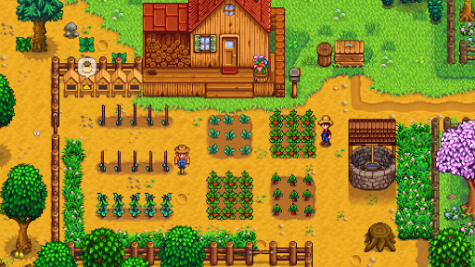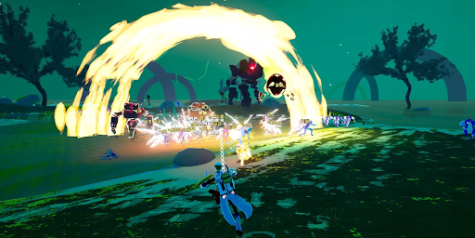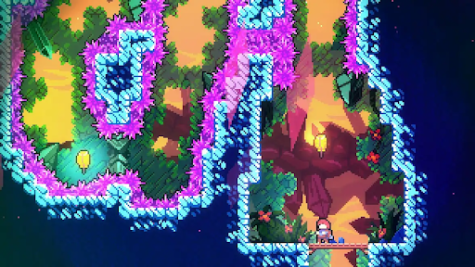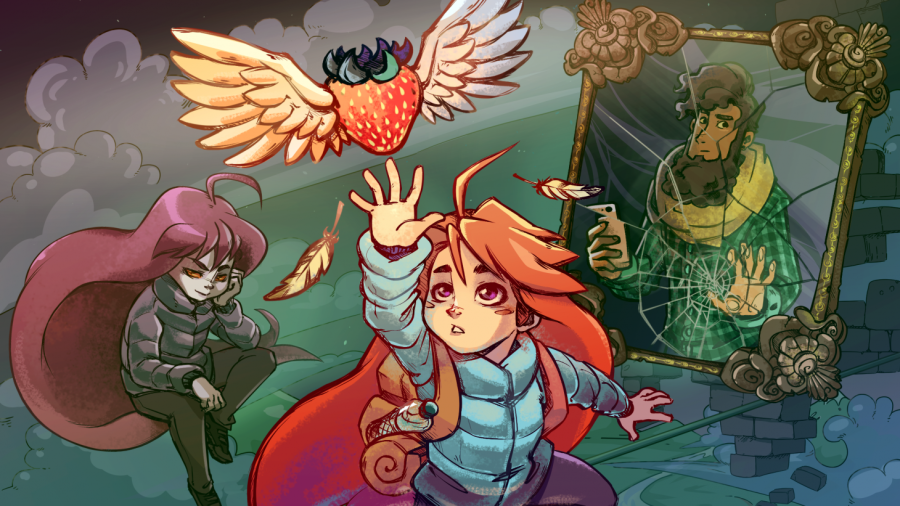Indie Video Games
January 28, 2023
It would be an understatement to say that Indie games have risen in popularity and importance in the past decade. In the past few years, they have consistently been some of the biggest releases in their respective year. Indie games are video games made by a very small team of developers of only 1 – maybe 20 people. For comparison, a major company like Ubisoft has almost 20,000 employees worldwide. While Indie games still don’t sell nearly as much as triple AAA releases from bigger developers (with the exception of Minecraft), they have been getting closer, and critically, they have been able to compete and in many cases surpass games made by bigger teams. After playing a lot of these types of games in the past year, it is clear to see that having a smaller team or budget doesn’t mean less quality in the game, but that doesn’t mean some cracks don’t exist.
Stardew Valley
Platforms: Everything
Price: $15 (goes on sale a lot)

This is a farming game, and one of the more popular ones. You grow crops, raise animals, get materials, and then sell your spoils to get more crops, animals, and materials. Along with your farm, you have an overworld with a town containing useful buildings, mines, a beach, a desert, and much more. There are also various NPCs roaming the world that you can trade with, do side quests through, and give gifts to. When it comes to your farm, there are tons of different crops you can grow, animals you can raise, structures you can build to turn a profit, and nice-looking decorations to make it the most boujee country farm it can be. All of this is pretty standard and there aren’t many super unique or unseen mechanics, but what makes this game so good is how it’s all put together.
Every “year” in the game is made of 4 seasons each with 28 days (a day usually ranges between 6-8 minutes) with your character waking up at 6:00 am. If you don’t go back to bed before 2:00 am, you “pass out”, lose money, lose stuff in your inventory, and don’t regain your energy gauge that allows you to do various actions. NPCs will also only come around certain areas and retire for the day at different times, and the buildings they own will also open and close at different times and days. On top of that, crops and animals take different amounts of time to be harvested, and certain crops can only be grown in certain seasons. Time-related systems are involved in almost every aspect of the game, making every day feel like a strategized speedrun.
The game also gives you incentives to interact with its many systems and NPCs as they can unlock new things to craft, crops to grow, stuff to buy, and even new unique areas to discover. The game breaks its profit-gaining systems into four groups: farming, fishing, foraging, and mining; the more you complete in one of these categories, the more you will level up in the category which will unlock more things to craft related to that category. The community center is a building where you can donate certain items to unlock stuff as well, motivating you to get a variety of materials each season. All of this gives a game with little to no action a lot of purpose, and I haven’t even mentioned the best part.
Playing this game in multiplayer with up to three other people makes it 100 times more fun. Of course, part of this is because doing stuff with friends is fun in general, but the previously mentioned time mechanics and strategy create some light competition and teamwork to accomplish the game’s numerous tasks. While this does make the game way more fun, it isn’t super well implemented all the time. No matter how good your internet is, the game will stutter and lag every once in a while, and even though it has only happened once or twice, the game can randomly disconnect you. If you have 4 players that have a farm in a world, you will basically have to play with everyone at the same time because playing without someone can lead to things like their crops dying or quest timers running out. To build buildings, you talk to an npc named Robin, but she can only build one thing at a time and it takes a few in-game days, so if you want to build something and someone has already commissioned Robin, you just have to wait. Even though it lacks some polish in this area, the pixel art was amazing to me even though I’m not a very big fan of most pixel art styles. The rest of the game is just straight quality and fun, and I would highly recommend it if you have a group of people to play it with.
Risk of Rain 2
Platforms: Also everything
Price: $25 and $15 DLC (both go on sale frequently)

Risk of Rain 2 is a roguelite game which is a game where you try and play through the whole game in one go and if you fail once you start over. When you describe it like this, this game sounds like it violates the Geneva convention, but roguelites put a massive amount of variation on each attempt and a good one will make every playthrough feel widely different. Most roguelites though are a 2d platformer, side scroller, or top-down game but Risk of Rain separates itself from the crowd by being a third-person multiplayer shooter in the genre. Each run starts with you and up to three other players picking among 14 characters with different weapons and abilities, and being dropped onto an alien planet where enemies will spawn and attack you. When you destroy an enemy, you get money that you can use to open boxes that give you upgrades and new abilities. To progress to the next area on each map, you have to activate a teleporter that is surrounded by a boss and other enemies. Traverse through five of these areas and you get the option to go to the final area where you take on the final boss to beat the game. The five areas you go through are randomized through many different maps, as well as multiple secret areas, alternate win conditions, and optional challenges that keep things interesting.
The highlight of the game is definitely the characters and items that upgrade said character. Barely any of these items are the usual, damage up, health up, defense up, but instead, these have cool gimmicks and utilities that can lead to absurd builds. Different items will be more useful for some characters than others and these gimmicks and utilities combo better with some items than others to such an extent that some combinations will make you feel untouchable, while some can actively hurt you. One run, the character I picked was “huntress” who can throw a blade that ricochets between multiple enemies and a blink that allows her to teleport a decent distance. During my run, I was able to stack an item that reduced ability cooldowns whenever I hit an enemy, an item that chained lighting to other enemies whenever an enemy was hit, and an item that halved my cooldowns but also halved my health. This made it so my blade would hit a ton of enemies in the area and refill my cooldowns almost instantly, allowing me to throw blades over and over again while teleporting constantly around the map. With 175 completely unique items in the game, there is no shortage of builds you can go for.
An important thing to mention when talking about roguelites is the difficulty, and this game definitely makes its credits a rare sight. The difficulty is done in a very fun way that makes its gameplay much more unique and interesting. You can set the difficulty between three levels at the start of a run, but when you are in a run, the difficulty increases as time increases. This makes you have to decide whether certain item boxes or shrines are worth going for, when you think you’re ready to take on the teleporter boss, what areas to go to, what enemies to defeat, and just encourages you to be fast in general. As the difficulty gets harder, the number of enemies will increase, but the game will more often than not just spawn different, much tougher enemies which keeps the screen from feeling too cluttered without sacrificing any tension.
Lastly, the visuals and multiplayer in the game are very good with a few exceptions. The visuals are great in most areas, with some super pretty alien worlds, a unique style, and cool enemy designs. However, the style can look a little gross or flat in the game’s simpler and more boring areas. There are only around two of these areas in the game though and they are usually starting areas that you get out of very quickly. The simple but clean style though makes enemies and projectiles very visible and clear. Multiplayer, like in many games, makes this one a lot more fun, and what’s nice is that to do the best you can you have to work together, but playing with friends doesn’t affect your ability to do your own thing and go for your own builds. The only problem I have with the multiplayer is that if you or a teammate dies early in a level, they miss out on getting any items until they respawn in the next level. This leaves them behind on items, meaning they are likely to die again and become even more behind on items. This can be solved by sharing items in the next level with that person, but it is far from convenient and means less items for you, putting you further behind. It’s not a very big issue though and I don’t really know how you fix it, or if it even needs fixing. Overall it is the best roguelite I’ve played easily, and one of the best shooters I’ve played.
Celeste
Platforms: Everything again
Price: $15 (Goes on sale every time the sun rises)

Celeste is one of the most infamous and well renowned indie games ever made. What’s so interesting about it is despite being so good (spoilers), it doesn’t really have any crazy or unique ideas or mechanics. It’s a 2d platformer where you go through 9 chapters in the main game and jump around obstacles to get to the end. Other than just the normal jump and wall jump the protagonist Madeline has an 8-way direction dash on the ground and in the air, and the ability to temporarily climb walls. What Celeste does with the simple movements and other gimmicks within levels is just really really fun. Every character movement and chapter mechanic is pushed to their limit, and despite the game only being made up of these challenges, it never gets boring and has some amazing sequences. Each chapter feels different from the last while still being pure platforming. The game has plenty of content with the main story and tons of post-game content. Each level is surprisingly open with many optional challenges you can take on to get strawberries that can unlock post-game content, and B-side and C-side tapes that unlock different, harder versions of the level. Overall there is a crazy amount of quality content for a fairly cheap indie game.
I don’t even have that much to say about the game because it is just very good. The visuals have some of the best pixel art to date, paired with the fitting music, it achieves a unique feeling and atmosphere in every area. What can’t invoke the same enjoyment is the story. You will sometimes be interrupted by character dialogue that goes on for a little too long. The story is about Madeline battling her inner anxiety, depression, and self-loathing with the main antagonist acting as those parts of herself, but it’s BORRRRRING and very generic. By the last chapters I was just skipping past the dialogue. The story doesn’t detract from the 11/10 gameplay though and it should be an immediate buy if you see it on sale.



Tristan • Jan 30, 2023 at 12:29 pm
Great article! I highly recommend Stardew Valley as well. It’s very fun to play with friends or even on your own.